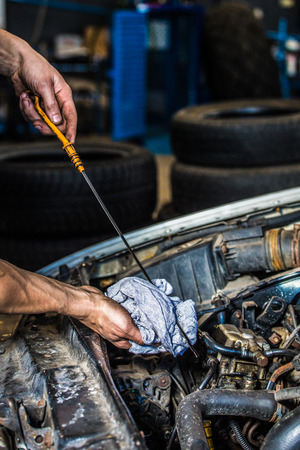Vroom, vroom. We all love the feeling of hitting the open road without a care in the world. But what happens when that enjoyment is suddenly interrupted by unexpected car troubles?
One common culprit of automotive issues is neglected transmission fluid. This vital component plays a crucial role in keeping your car in tip-top shape and ensuring a smooth driving experience. However, many drivers are unaware of how often they should check their transmission fluid or why it’s even necessary.
In this blog post, we’ll dive into everything you need to know about transmission fluid: how it works, why it’s important to check regularly, and how to properly maintain it for maximum longevity. So buckle up and get ready for an informative ride on checking your transmission fluid!
The Importance of Transmission Fluid and its Role in Vehicle Performance
The transmission fluid is the lifeblood of your car’s transmission system. It’s a slick liquid that cools, lubricates, powers and protects the moving parts of your transmission. Its primary function is to ensure that everything runs smoothly and efficiently.
Without adequate transmission fluid, your vehicle’s gears could grind, leading to a rough ride or even damaging your transmission altogether. The fluid also helps to regulate the heat generated by the transmission, preventing overheating and the associated complications.
Regular and routine checks of this essential fluid can drastically improve your vehicle’s performance, extending its lifespan and saving you costly repairs down the road.
How to Check Your Transmission Fluid: A Step-by-Step Guide
Before we get into the steps, there are a few tools and materials you’ll need on hand:
- Clean, lint-free rag or paper towel
- Safety gloves and glasses
- Your vehicle’s owner’s manual
Here’s a step-by-step guide on how to check your transmission fluid:
- Ensure Safety: Before you begin, ensure you’re parked on a level surface and put on your safety gloves and glasses to protect yourself from any hot components or fluid splashes.
- Warm Up the Vehicle: Start your car and let it run for a few minutes. The transmission fluid should be warm for an accurate reading.
- Find the Transmission Dipstick: Refer to your vehicle’s owner’s manual to locate the transmission dipstick. It’s typically found towards the back of the engine bay.
- Remove and Clean the Dipstick: Pull out the dipstick and wipe it clean with your rag or paper towel. It will ensure an accurate reading.
- Insert the Dipstick and Pull it Out Again: Reinsert the dipstick fully, then pull it out again. This time, note the fluid level on the end of the stick. It should fall within the ‘safe’ markings.
- Check the Fluid Condition: As well as checking the level, look at the fluid’s color. Clear, red fluid is healthy. If the fluid is brown or smells burnt, it may be time for a fluid change.
Remember, safety is paramount when performing any DIY vehicle maintenance. Always refer to your vehicle’s owner manual for specific instructions regarding your make and model.
Signs Indicating Your Transmission Fluid Needs a Change or Top-Up
Identifying issues related to your transmission fluid early can save you from costly repairs and inconvenience down the line. Here are some common signs indicating that your transmission fluid may require a change or top-up:
- Strange Noises: If your vehicle starts making unusual sounds like grinding or clunking while you’re driving or shifting gears, this could signify that your transmission fluid is low or dirty.
- Difficulty Shifting Gears: If your vehicle hesitates or refuses to go into gear, this is a clear sign of low transmission fluid.
- Slipping Gears: If your car is spontaneously popping in and out of gears while you’re driving, it’s a significant indication that you might have a transmission fluid problem.
- Surging of the Vehicle: If your vehicle surges forward or falls backward for no apparent reason, this could indicate that your car’s transmission fluid is dirty and can no longer maintain adequate pressure.
- Delayed Vehicle Movement: If there’s a delay or noticeable pause before your vehicle begins to move after you’ve shifted into drive or reverse, your transmission fluid could be at a dangerously low level.
Remember, these signs are just indicators and may not necessarily mean a transmission fluid problem. If you experience any of these signs, consult a professional mechanic for a proper diagnosis. Always prioritize safe and regular vehicle maintenance to keep your car running optimally.
Consequences of Ignoring Transmission Fluid Maintenance
Neglecting your transmission fluid can have severe consequences, ultimately leading to decreased performance, costly repairs, and a shorter lifespan for your vehicle. Let’s delve into the potential impacts of failing to maintain your transmission fluid:
- Expensive Repairs: One of the significant consequences of ignoring transmission fluid maintenance is the potential for costly repairs. A well-lubricated transmission is less likely to break down or have parts fail. However, when the fluid is low or dirty, the risk of malfunction drastically increases. If your transmission fails, it can result in repair bills that may run into the thousands of dollars.
- Decreased Fuel Efficiency: Transmission fluid plays a vital role in ensuring your vehicle operates efficiently. When your transmission fluid is not effectively lubricating the moving parts, your car has to work harder, leading to increased fuel consumption and decreased fuel efficiency.
- Decreased Vehicle Performance: Inadequate transmission fluid can also negatively impact your vehicle’s overall performance. You might notice a delay in gear shifting, erratic shifting, or even complete loss of gear. These performance issues not only make for an uncomfortable driving experience but can also be dangerous.
- Shortened Vehicle Lifespan: Ultimately, failing to maintain your transmission fluid can shorten the lifespan of your vehicle. The additional strain on the transmission components due to inadequate lubrication can lead to premature wear and tear, and ultimately a reduced lifespan for your vehicle.
Regular and proper checks of your transmission fluid are essential in ensuring a smooth, safe, and economical driving experience.
Conclusion
Maintaining your transmission fluid is not just a suggestion, but a crucial requirement for the health and longevity of your vehicle. The effect of poor transmission fluid maintenance can be catastrophic, resulting in huge repair costs and decreased vehicle performance.
On the flip side, regular and thorough checks of your transmission fluid can result in a smoother ride, improved fuel efficiency, and an extended lifespan for your vehicle. So, next time before you hit the road, make sure to pay heed to this unsung hero of your car’s performance – the transmission fluid.
Remember, a little attention today can prevent a big headache tomorrow. Safe driving!
About Jet Auto Transmission-
If you are looking for a local auto repair shop in Davie, FL, to repair your transmission, bring your vehicle to Jet Auto Transmission for effective, affordable repairs that last a long time.
Our mechanics have decades of experience handling transmission repairs and replacements. Our entire staff is ASE certified, and we have been serving the residents of West Park, Florida, since 1987. If you need automotive performance shops in Florida for vehicle repair, don’t hesitate to call us at (954) 251-1204. Our services offer economical vehicle repair, upfront costs, and a free quote.

